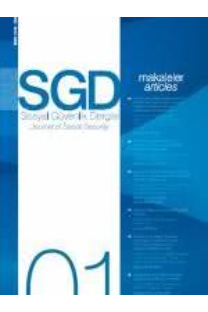Değişen İstihdam Yapısı ve Genç İşsizlerin Gözünden Sendikalar
Changing Emloyment Structure and Trade Unions Perceptions of the Young Employment
___
- Allvin, M. ve Sverke, M. (2000). Do New Generations Imply the End of Solidarity? Swedish Unionism in the Era of Individualization. Economic and Industrial Democracy. 21. 71-95.
- Altan, Ö. Z., Kağnıcıoğlu, D., Şişman, Y. ve Sungur, Z. (2005). İşçi Profil Araştırması: Eskişehir Örneği. Eskişehir: Anadolu Üniversitesi Yayınları.
- Barling, J., Kelloway, E. K. and Bremermann, E. H. (1991). Preemployment Predictors of Union Attitudes: The Role of Family Socialization and Work Beliefs. Journal of Apllied Psychology. 76(5). 725-731.
- Bayhan, V. (2013). Türkiye’de Gençlik: Sorunlar, Değerler ve Değişimler. M. Zencirkıran (Ed.), Dünden Bugüne Türkiye’nin Toplumsal Yapısı. Bursa: Dora Yayınevi. s. 367-401.
- Blanden, J. and Machin, S. (2002). Cross- Generations Correlations of Union Status for Young People in Britain. London School of Economics and Political Science: Centre for Economic Performance.
- Building and Wood Worker’s-BWI. (2013). Youth, the Labour Market and Trade Unions (Summary Report). Bangkok.
- Diamond, W. J. and Freeman, R. B. (2002). Will Unionism Prosper in Cyberspace? The Promise of the Internet for Employee Organization. British Journal of Industrial Relations. 40(3). 569-596.
- Ebbinghaus, B. (2002). Trade Unions’ Changing Role: Membership Erosion, Organisational Reform, and Social Partnership in Europe. Indsutrial Relations Journal. 33(5). 465-483.
- Fontes, M. and Margolies, K. (2010). Youth and Unions. Cornell University ILR School: Working Paper.
- Gomez, R., Gunderson, M. and Meltz, N. (2002). Comparing Youth and Adult Desire for Unisation in Canada. British Journal of Industrial Relations. 40(3). 521-542.
- Gordon, P. A. (2018). Age Diversity in the Workplace. C.T.E. de Aquino and R.W. Robertson (Ed.), Diversity and Inclusion in the Global Workplace: Aligning Initiatives with Strategic Business Goals. (31-47). Houndmills: Palgrave Macmillan.
- Griffin, L. and Brown, M. (2011). Second Hand Views? Young People, Social Networks and Positive Union Attitudes. Labour and Industry. 22(1-2). 83-101.
- Haynes, P., Vowles, J. and Boxall, J. (2005). Explaining the Younger-Older Worker Union Density Gap: Evidence From New Zealand. British Journal of Industrial Relations. 43(1). 93-116.
- Hekimler, B. U. (2015). Türkiye’de Olumsuz Sendikal Algının İçsel ve Dışsal Nedenleri. Sosyal Siyaset Konferansları. 1(68). 127-154. [https://biruni.tuik.gov.tr/medas/?kn=72&locale =tr]. (Erişim: 08.05.2019)
- [https:// www. cognifit. com/ tr/ perception ]. (Erişim: 03.05.2018)
- [https:// www. ilo. org/ ankara/ conventions- ratified- by- turkey/ WCMS_ 377281/ lang-- tr/index.htm]. (Erişim: 03.05.2018)
- [https://www.eurofound.europa.eu/observatories/ eurwork/industrial-relations-dictionary/ young- workers]. (Erişim: 03.05.2018)
- Kahmann, M. (2002). Trade Unions and Young People: Challenges of The Changing Age Composition of Unions. [http://citeseerx.ist.psu.edu/viewdoc/download;j sessionid =7CE8F66893AEF1EF59A8324C9 C393790? doi=10.1.1.599.2618&rep=rep1& type=pdf]. (Erişim: 13.04.2018)
- Keune, M. (2015). Trade Unions and Young Workers In Seven EU Countries: Final Report. European Union.
- Lowe, G. S. and Krahn, H. (2000). Work Aspirations and Attitudes in an Era of Labour Market Restructuring: A Comparison of Two Canadian Youth Cohorts. Work. Employment & Society. 14(1). 1-22.
- Lowe, G. S. and Rastin, S. (2000). Organizing the Next Generation: Influences on Young Workers’ Willingness to Join Unions in Canada. British Journal of Industrial Relations. 38(2). 203-222.
- Mengi, Z. (2009). [https://groups. yahoo.com/neo/groups/mbamarketingmanagem ent 2008/conversations/ topics/45]. (Erişim: 21.05.2014).
- Müftüoğlu, Ö. (2006). Kriz ve Sendikalar. F. Sazak, (Ed.). Türkiye’de Sendikal Kriz ve Sendikal Arayışlar İçinde. 117-156. Ankara: EPOS Yayınları.
- Pascual, A. S. and Waddington, J. (2000). Young People: The Labour Market and Trade Unions. Youth Committe of the European Trade Union Confederation.
- Pedersini, R. (2010). Trade Union Strategies to Recruit New Groups of Workers. [http://www.eurofound.europa.eu/docs/eiro/tn0 901028s/tn0901028s.pdf]. (Erişim: 22.11.2016).
- Tailby, S. and Pollert, A. (2011). Non- Unionized Young Workers and Organizing The Unorganized. Economic and Industrial Democracy. 32(3). 499-522.
- Tekin, Ö. A. ve Tüfekçi, Ö. K. (2015). Turizm Öğrencilerinin Sendika Algısı: Üniversite Öğrencileri Üzerine Bir Araştırma. Afyon Kocatepe Üniversitesi Sosyal Bilimler Dergisi. 17(1). 171-200.
- Tokol, A. (2014). Genç İşçiler ve Sendikalar. Türk Metal Dergisi. (184). 40-45.
- Turner, T. and D’art, D. (2012). Public Perceptions of Trade Unions in Countries of the European Union: A Causal Analysis. Labor Studies Journal. 37(1). 33-55.
- Vandaele, K. (2012). Youth Representatives’ Opinions on Recruiting and Representing Young Workers: A Twofold Unsatisfied Demand? European Journal of Industrial Relations. 18(3). 203-218.
- Vandaele, K. (2018). How can trade unions in Europe connect with young workers? [https://www.researchgate.net/publication/3209 61521_How_can_trade_unions_in_Europe_con nect_with_young_workers?enrichId=rgreq82f7 ae69142dd5988a8a8620d415feb9XX&enrichS ource=Y292ZXJQYWdlOzMyMDk2MTUyMT tBUzo1NTg4Njc4NDQyMTA2ODhAMTUxM DI1NTg4NTA5NQ%3D%3D&el=1_x_2&_esc =publicationCoverPdf]. (Erişim: 22.06.2018).
- Visser, J. (2002). Why Fewer Workers Join Unions in Europe: A Social Custom Explanation of Membership Trends. British Journal of Industrial Relations. 40(3). 403-430.
- Waddington, J. and Whitston, C. (1997). Why Do People Join Unions in a Period of Membership Decline? British Journal of Industrial Relations. 4(35). 515-546.
- Yelkikalan, N. ve Altın, E. (2010). Farklı Kuşakların Yönetimi. Yönetim Bilimleri Dergisi. 8(2). 13-17.
- Yılmaz, Ç. (2015). İşçilerin Sendikal Örgütlenmeye Dair Tutumları: Petro-Kimya Sektörü Örneği. Çalışma ve Toplum. 4(47). 95- 130.
- Yorgun, S. (2007). Dirilişin Eşiğinde Sendikalar Yeni Eğilimler Yeni Stratejiler. Bursa: Ekin Yayınevi.
- Yücebalkan, B. ve Aksu, B. (2013). Potansiyel İşgücü Olarak Y Kuşağının Transformasyonel Liderlerle Çalışabilirliğine Yönelik Bir Araştırma. Organizasyon ve Yönetim Bilimleri Dergisi. 5(1). 16-32.
- ISSN: 2146-4839
- Yayın Aralığı: 2
- Başlangıç: 2011
- Yayıncı: SOSYAL GÜVENLİK KURUMU
Uluslararası İlke ve Standartlar Bağlamında Yaşlı Hakları ve Sosyal Hizmet Uygulamaları
Türkiye’de Emeklilik Sistemlerinin Yaşlı ve Emekli Yoksulluğu Üzerine Etkisi
Kendi Hesabına Çalışanların Kayıt Dışı İstihdama Bakışı
Türkiye Tarım Sektöründe Emek Verimliliği ve İstihdam İlişkisinin İncelenmesi
İşgücü Piyasası Durumları Arasındaki Geçişlerin Markov Modelleri ile İncelenmesi
Değişen İstihdam Yapısı ve Genç İşsizlerin Gözünden Sendikalar
